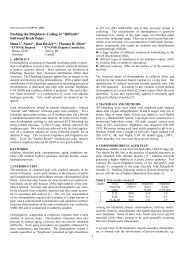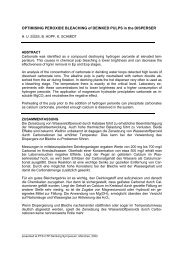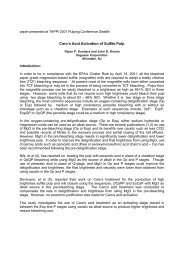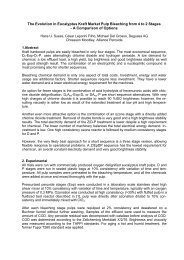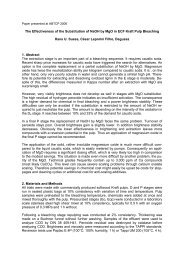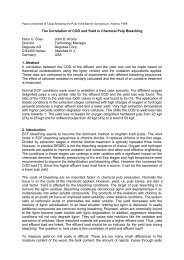paper presented at 2001 TAPPI PULPING CONFERENCE ...
paper presented at 2001 TAPPI PULPING CONFERENCE ...
paper presented at 2001 TAPPI PULPING CONFERENCE ...
- No tags were found...
Create successful ePaper yourself
Turn your PDF publications into a flip-book with our unique Google optimized e-Paper software.
<strong>paper</strong> <strong>presented</strong> <strong>at</strong> <strong>2001</strong> <strong>TAPPI</strong> <strong>PULPING</strong> <strong>CONFERENCE</strong>abbrev<strong>at</strong>ed versionHYDROGEN PEROXIDE in an ECF BLEACH PLANT: CENIBRA’s INDUSTRIAL EXPERIENCEHENRIQUE, Paulo Molinar *; COSTA, Marcelo Moreira *; CORREIA, Flávio Marcelo *; FONSECA, Maria JoséOliveira *; SANTOS, Jorge Roberto Cardoso *; LANDIM, Alexandre Brandão *; FILHO, César Leporini ***Celulose Nipo-Brasileira S.A.- CENIBRA, ** DEGUSSAABSTRACT:With the purpose of expanding production of ECF bleached eucalyptus Kraft pulp, CENIBRA evalueted inlabor<strong>at</strong>ory and mill tests altern<strong>at</strong>ives with the applic<strong>at</strong>ion of hydrogen peroxide in its ECF bleaching sequenceD 0 EoD 1 D 2 . The addition of hydrogen peroxide in this production line aims <strong>at</strong> a chlorine dioxide demandoptimiz<strong>at</strong>ion and an increase of the production, maintaining 90 ± 0.5% ISO brightness. The following sequenceswere investig<strong>at</strong>ed: D 0 EopD 1 D 2 , D 0 EoD 1 P, D 0 EoD 1 (QP) and D 0 EopD 1 P. Industrial results confirmed the labor<strong>at</strong>orytests, showing replacement r<strong>at</strong>es variing from 1.1 to 2.4 kg ClO 2 /kg H 2 O 2 . More <strong>at</strong>tractive replacement r<strong>at</strong>es wereobtained for the addition of 2.5 kg H 2 O 2 /adt in the last bleaching stage (D 0 EoD 1 P). However, a larger substitution ofthe total chlorine dioxide demand was found with the sequence D 0 EopD 1 P (5 kg H 2 O 2 /adt divided between bothapplic<strong>at</strong>ion points), which decreased the demand by 7.7 kg of ClO 2 /adt for kappa number 8.6 pulp. In addition, pulpand effluent characteristics are described for each altern<strong>at</strong>ive, as well as corrosion r<strong>at</strong>es of titanium under alkalineconditions (pH < 11), with low concentr<strong>at</strong>ions of hydrogen peroxide (< 0.1%). Results show th<strong>at</strong> the addition ofhydrogen peroxide in existent bleaching plants allows increased production without a modific<strong>at</strong>ion of the chlorinedioxide gener<strong>at</strong>ion <strong>at</strong> acceptable levels for oper<strong>at</strong>ion costs and pulp properties.Key Words: ECF peroxide bleaching; sequence flexibiliz<strong>at</strong>ion; production increase; replacement ofClO 2 /H 2 O 2; titanium corrosion; Eucalyptus spp.1. INTRODUCTIONDuring the last two decades, pulp-bleaching plants underwent a large number of modific<strong>at</strong>ions. Bleachingprocesses using chlorine chemicals still domin<strong>at</strong>e and will maintain this dominance Modern bleaching technologymakes use of oxygen and oxygen deriv<strong>at</strong>ives, such as hydrogen peroxide, peracids and ozone. In theirimplement<strong>at</strong>ion special <strong>at</strong>tention must be given to the bleach plant m<strong>at</strong>erial comp<strong>at</strong>ibility in order not to destroy theequipement.2. OBJECTIVEThis <strong>paper</strong> demonstr<strong>at</strong>es CENIBRA’s labor<strong>at</strong>ory and plant experience with the applic<strong>at</strong>ion of hydrogenperoxide in the D 0 EoD 1 D 2 type ECF bleaching sequence. The aim was to increase the production flexibility and tosubstitute a part of the chlorine dioxide with hydrogen peroxide for market brightness (90 ± 0,5% ISOThe existingcapacity for the gener<strong>at</strong>ion of chlorine dioxide should be suffcient despite the production increase. ). The existingbleach plant should be used and not be affected by corrosion.3 - EXPERIMENTALFor comparison purposes, in the labor<strong>at</strong>ory and <strong>at</strong> plant level the implement<strong>at</strong>ion of hydrogen peroxide in theECF - D 0 EoD 1 D 2 , bleaching sequence was investig<strong>at</strong>ed, aiming <strong>at</strong> a brightness of 90 ± 0,5% ISO. Thus, thebleaching sequences evalu<strong>at</strong>ed were: D 0 EopD 1 D 2 , D 0 EoD 1 P, D 0 EoD 1 (QP) and D 0 EopD 1 P. Table 1 shows the mostimportant conditions. In sequence D 0 EoD 1 (QP) a chel<strong>at</strong>ing agent <strong>at</strong> a constant dosage of 0,6 kg/adt was added,together with hydrogen peroxide and sodium hydroxide. The washing of the pulp between the bleaching stages wascarried out with 9 m 3 /adt in the labor<strong>at</strong>ory and in the plant <strong>at</strong> 8 to 10 m 3 /adt in the diffusion washers as shownschem<strong>at</strong>ically in Figure 6.
Table 1 – The main conditions of the labor<strong>at</strong>ory and plant tests.2Main ConditionsBleaching stagesD 0 Eo/Eop D 1 D 2 PConsistency %* 10 10 8 - 10 8 - 10 8 – 10Time, min 40 70 165 165 165Temper<strong>at</strong>ure, ºC 50 80 75 75 75pH ~3,0 11,5 var. var. 11,0H 2 SO 4 amount, kg/adt 8 - 10 - - - -O 2 amount, kg/adt - 3 - - -NaOH amount, kg/adt -
3CELULOSE E PAPEL, ABTCP. INTERNATIONAL ORGANIZATION FOR STANDARDIZATION, ISO.SCANDINAVIANPULP, PAPER AND BOARD, SCAN Testing Committee. Stockholm, SCAN. (s.d.). STANDARDMETHODS, Examin<strong>at</strong>ionof W<strong>at</strong>er and Wastew<strong>at</strong>er (APHA/ AWWA/ WEF). 20 ed., 1998. PAPIERTECHNISCHE STIFTUNG FURFORSCHUNG UND AUSBILDUNG IN PAPIERZEUGUNG UND PAPIERVERARBEITUNG.32 PULPTESTING. “Determin<strong>at</strong>ion of the totalHalogen<strong>at</strong>ed Organics OX Content”. <strong>TAPPI</strong> Standard Methods. Atlanta, <strong>TAPPI</strong>. (s.d.) and <strong>TAPPI</strong> Usefulmethods. Atlanta, <strong>TAPPI</strong>.Table 2 – The main parameters analyzed including the analytical procedures.Analyzed Parameters Methodology Analyzed Parameters MethodologyKappa Number <strong>TAPPI</strong> – 236 Blow-out index, kPa.m 2 /g <strong>TAPPI</strong> - 403Viscosity, mPa*s <strong>TAPPI</strong> – 230 Tearing index, mN.m 2 /g <strong>TAPPI</strong> - 414Brightness, % ISO ISO – 2469 Specific volume, cm 3 /g <strong>TAPPI</strong> - 411After color number (NCP) CENIBRA Air resistance, s/100 ml <strong>TAPPI</strong> - 460Permangan<strong>at</strong>e Number (NP) ABTCP C4 Light dispersion coefficient, <strong>TAPPI</strong> - 425cm 2 /gPentosanas, % <strong>TAPPI</strong>-223 Opacity, % <strong>TAPPI</strong> - 425Chloride, mg/lSTANDARD Soluble extractibles in DCM, % ISO - 624METHODSRefining PFI, Total load <strong>TAPPI</strong> - 248 Total halogen<strong>at</strong>ed compounds PTS - RH: 012/90(OX), mg/lSheet confection <strong>TAPPI</strong> - 205 Titanium corrosion r<strong>at</strong>e ASTM G1 -81/G31-72Shopper-Riegler, ºSR SCAN C19 Color, kg Pt/ adt STANDARDMETHODSDrainability Freeness, ml SCAN C21 Chemical oxygen demand (COD),kg O 2 / adtSTANDARDMETHODSTraction index, N.m/g <strong>TAPPI</strong> - 494 Adsorbable organo halogen<strong>at</strong>edcompounds (AOX), kg Cl - / adtSCAN-W94. RESULTS4.1. Labor<strong>at</strong>ory tests4.1.1. Bleaching testsA sample of industrially oxygen delignified pulp with a Kappa number of 8,5 was used for the reference. 20,4 kgof chlorine dioxide as Cl 2 active/adt in stage D 0 (FK = 0,24) and 12 kg NaOH/adt in Eo were used. Figure 7 presents thelabor<strong>at</strong>ory tests with several vari<strong>at</strong>ions for the amount of chlorine dioxide in stage D 1 , however, with fixed addition of thischemical in stage D 2 (4 kg Cl 2 active/adt) and hydrogen peroxide in stage P (2,5 kg H 2 O 2 /adt) for the sequencesD 0 EoD 1 D 2 and D 0 EoD 1 P, respectively. In stage D 2, the chlorine dioxide loads are the usual ones in the process, whilst theload of hydrogen peroxide was optimized in the labor<strong>at</strong>ory based the consumption under process conditions. In thelabor<strong>at</strong>ory, it was observed th<strong>at</strong> the change of stage D 2 for a final P results in a substitution factor of 1,82 kg ClO 2 /kgH 2 O 2 .One of the reserv<strong>at</strong>ions in respect to a substitution of part of the chlorine dioxide with hydrogen peroxide inan ECF sequence is the potential increase of the lignin residual in the pulp. This residual can be measured by thepermangan<strong>at</strong>e number (NP) and correl<strong>at</strong>es with the brightness reversion of the pulp. Usually under normal processconditions, NP values lower than 1 result in better brightness stability, or, in other words, a smaller brightness lossduring an acceler<strong>at</strong>ed reversion test.
4FS ~ 1,82 kg ClO 2 /kg H 2 O 2929088Brightness,%ISO868482807876Pulp D 0 Eo#Kappa = 2,9Viscosity = 21,8 cPBrightness = 76,0 % ISOD 0 EoD 1 P (2,5 kg H 2 O 2 /tsa)D 0 EoD 1 D 2 (4 kg Cl 2 active/tsa)D 0 EoD x (2 - 12 kg Cl 2 active/tsa)740 2 4 6 8 10 12 14ClO 2 chargein D 1 , kg ClO 2 c/ Cl 2 activeFigure 7 – Substitution factor <strong>at</strong>tained by the applic<strong>at</strong>ion of hydrogen peroxide in the last bleaching stage(D 0 EopD 1 D 2 vs. D 0 EoD 1 P) for a brightness of 90 % ISO.The values measured in Figure 8 indic<strong>at</strong>e th<strong>at</strong> for similar NP levels, usually under 1, pulp gener<strong>at</strong>ed in the D 0 EoD 1 Psequence show brightness reversal values (1h <strong>at</strong> 105 ± 3 ºC), slightly lower or similar to pulp bleached withD 0 EoD 1 D 2 . This can be explained, considering th<strong>at</strong> an alkaline stage in the presence of hydrogen peroxide isefficient in the removal of carbonyl groups present in carbohydr<strong>at</strong>es [3] which is one of the main causes of brightnessreversion in bleached Kraft pulps.2,3Reverted points, % ISOD 0 EoD 1 D 21,9D 0 EoD 1 P1,51,10,786 87 88 89 90 91 92Final brightness, % ISOFigure 8 – Brightness reversion of pulp bleached in D 0 EoD 1 D 2 and D 0 EoD 1 P sequences.Besides the worries about the stability of the brightness, the presence of equipment constructed with titaniumcould potentially thre<strong>at</strong> the use of hydrogen peroxide. The liter<strong>at</strong>ure is not clear concerning corrosion. Therefore, aseries of corrosion tests were conducted with the titanium m<strong>at</strong>erial, simul<strong>at</strong>ing industrial conditions in stage P.4.1.2. Titanium corrosion tests in alkaline media in the presence of H 2 O 2The behavior of titanium alloys, used in the bleaching stages, was one of the obstacles for a mill test.Therefore corrosion tests were made. The titanium corrosion r<strong>at</strong>es in alkaline media containing small hydrogenperoxide concentr<strong>at</strong>ions was checked. The addition of hydrogen peroxide was simul<strong>at</strong>ed for the oxid<strong>at</strong>ive extraction(Eo) and the last stage of the D 0 EoD 1 D 2 sequence, where the rotor of the mixer and the filter mesh of the stage (D 2 )diffuser are made of grade 2 titanium.
5Titanium is well known for its excellent corrosion resistance in chlorine containing media, especially underhighly oxid<strong>at</strong>ive conditions. Such resistance makes it very <strong>at</strong>tractive for applic<strong>at</strong>ion in bleaching processes. Its use isrecognized in the pulp and <strong>paper</strong> industry since the sixties, specifically in chlorine dioxide gener<strong>at</strong>ion plants,diffusers, pulp washers, sodium hypochloride storage and systems containing wet chlorine [25] .Table 3 shows the test samples, the conditions of their exposure and the main properties or changes observedon their surfaces. For the corrosion r<strong>at</strong>e calcul<strong>at</strong>ion, the density of the alloy was considered being constant and equalto 4,51 g/cm³ [26] . Linear measurements were made using a caliper rule. For every weighing set, the analyticalbalance was previously calibr<strong>at</strong>ed. The values of the differences resulted from the third and the second decimalplace. Thus, the corrosion test precision can be reported as being as good as 0,001 mm/a.0,023Table 3 – Corrosion r<strong>at</strong>es of titanium samples with and without welding, two pH values, and two different hydrogenperoxide concentr<strong>at</strong>ions.Identific<strong>at</strong>ion Corrosion media Corrosion r<strong>at</strong>e, mm/a # Corrosion productsCP*A pH10 ± 0,10,0060,03 ± 0,01 % H 2 O 2B pH10 ± 0,10,009No visual changes0,1 ± 0,02 % H 2 O 2C pH11 ± 0,10,03 ± 0,01 % H 2 O 20,005D pH11 ± 0,10,0160,1 ± 0,02 % H 2 O 2E pH11 ± 0,10,012White scale and change in0,1 ± 0,02 % H 2 O 2glossF pH11 ± 0,10,1 ± 0,02 % H 2 O 2* Identific<strong>at</strong>ion of the titanium samples grade 2: no welding (A, B,C,D), normally welded (E) and weldingshowing thermally affected areas (F). The area of the test samples was 17,2 – 0,14 cm 2 .# Main corrosion test conditions: temper<strong>at</strong>ure 75ºC, retention time 120h. The reaction media was theindustrial filtr<strong>at</strong>e from stage D 1 , containing 19,3 mg *l -1 of Ca 2+ and 2,8 mg *l -1 of Mg 2+ .The resistance of m<strong>at</strong>erials in any corrosive medium is rel<strong>at</strong>ed to the corrosion r<strong>at</strong>es independently of thecorrosive medium to which it was exposed [27] . Reference values indic<strong>at</strong>e th<strong>at</strong> low corrosion r<strong>at</strong>es were observed forthe pH conditions evalu<strong>at</strong>ed, the hydrogen peroxide concentr<strong>at</strong>ion and the test samples. A higher corrosion r<strong>at</strong>e wasfound in the welded test specimen which had thermally affected areas. This was reported also in other studies [25] . Inthis study the titanium corrosion r<strong>at</strong>e <strong>at</strong> pH 10 and 5% of hydrogen peroxide showed values of 0,43 and 0,46 mm/a.Tests were carried out by immersion in autoclaves <strong>at</strong> 70 ºC during 48h, which are test conditions similar to thoselisted in Table 3. Comparing these results with those found on the test samples B, it is evident th<strong>at</strong> there is a linearrel<strong>at</strong>ionship based on the hydrogen peroxide concentr<strong>at</strong>ion within this mentioned range.Looking <strong>at</strong> Table 3, it will be noted th<strong>at</strong> for H 2 O 2 ≤ 0,03% (~ 3 kg/adt) concentr<strong>at</strong>ions, corrosion r<strong>at</strong>es arelow, resulting in a noteworthy corrosion resistance property [27] . Increasing the H 2 O 2 concentr<strong>at</strong>ion in the medium, <strong>at</strong>endency towards an increase in the corrosion r<strong>at</strong>e <strong>at</strong> both evalu<strong>at</strong>ed pH levels can be observed. Therefore, duringthe plant test an important precaution was the control of the hydrogen peroxide addition to less than 3 kg/adt. Other<strong>paper</strong>s describe higher corrosion r<strong>at</strong>es (2 and 2,5 mm/a) for pH 11 and a peroxide concentr<strong>at</strong>ion of 0,03%. In thepresent work, the test samples were previously passiv<strong>at</strong>ed in a H 2 O 2 /HF mix carried out <strong>at</strong> 80°C during 7h. It wasnoted th<strong>at</strong> the corrosion r<strong>at</strong>es are strongly influenced by pH [28] .The available liter<strong>at</strong>ure shows controversal d<strong>at</strong>a regarding the titanium corrosion in alkaline media and thepresence of hydrogen peroxide. During an industrial test of 6,5 hours; hydrogen peroxide concentr<strong>at</strong>ion up to 0,26%and a pH up to 11,2 <strong>at</strong> 80°C, a corrosion r<strong>at</strong>e of 0,0025mm/a was reported. The same author also confirmed th<strong>at</strong>corrosion tests carried out in labor<strong>at</strong>ory by linear polariz<strong>at</strong>ion resistance (LPR) show much higher corrosion values.Afterwards, trying to simul<strong>at</strong>e industrial conditions, de-ionized w<strong>at</strong>er was exchanged for filtr<strong>at</strong>e from Eo (Ca 2+ = 12mg*l -1 and Mg 2+ = 5 mg*l -1 ) and the labor<strong>at</strong>ory tests were repe<strong>at</strong>ed. In this test the corrosion r<strong>at</strong>e (0,01 mm/a) wasclose to those obtained in the plant test [29] . Probably there are titanium corrosion inhibitors present in the alkaline
6media in the presence of hydrogen peroxide even under high loads of this chemical as mentioned before. Calciumand magnesium ions [29,30,31] , as well as cellusose fibers [30] are being mentioned as titanium corrosion inhibitors.It was noted th<strong>at</strong> <strong>at</strong> a pH of 10 to 11, for a hydrogen peroxide concentr<strong>at</strong>ion varying about 0,03%, there wasno form<strong>at</strong>ion of scale nor changes in the characteristic gloss of the test samples (silvery). However, the samplessubmitted to a concentr<strong>at</strong>ion of about 0,10% hydrogen peroxide <strong>at</strong> pH 10 to 11, showed changes in the metallicgloss towards a golden appearance, together with the form<strong>at</strong>ion of a white scale, close to the supporting hole of thesamples and <strong>at</strong> the edges. The test samples with normal welding and thermally affected also showed a change in thecharacteristic gloss and the form<strong>at</strong>ion of scale. It is believed th<strong>at</strong> the change in gloss corresponds to a macroscopicresponse associ<strong>at</strong>ed to an initial corrosion stage, involving the full surface of the metal. The form<strong>at</strong>ion of gas <strong>at</strong> thesame places where the form<strong>at</strong>ion of thicker and less adherent scale occurred, may be rel<strong>at</strong>ed to the decomposition ofthe hydrogen peroxide and the conversion of this first layer into the final corrosion products. Despite of thelimit<strong>at</strong>ions for these corrosion test, the resulting low corrosion r<strong>at</strong>es <strong>at</strong> pH < 11 and < 10 kg H 2 O 2 /adt, demonstr<strong>at</strong>eth<strong>at</strong> the corrosion in titanium equipment during an industrial test of 6 days would be without significance.4.2. Plant test using H 2 O 2 in the D o EoD 1 D 2 sequence4.2.1. Characteristics of the process and cost evalu<strong>at</strong>ionThe main objective of the plant test was to achieve a brightness close to 90 %ISO, using hydrogen peroxideand replace a part of the chlorine dioxide in the D o EoD 1 D 2 sequence. For the correct evalu<strong>at</strong>ion of the resultsobtained during the plant test, three basic consider<strong>at</strong>ions were taken into account: (1) clear separ<strong>at</strong>ion of the differentsequences D o EopD 1 D 2 , D o EoD 1 P, D o EoD 1 P(QP) and D o EopD 1 P, disregarding the intermedi<strong>at</strong>e phases between thesequences; (2) comparison of the sequences <strong>at</strong> the same range of final brightness, as well as (3) comparison of theconsumption of chemicals and the cost of bleaching in rel<strong>at</strong>ion to the Kappa number.Based on the production timetables for each evalu<strong>at</strong>ed sequence, the consumption of chemicals wascomputed as well as the oper<strong>at</strong>ional cost with regard to the reference sequence (D 0 EoD 1 D 2 ), as can be seen in Table4 and Figure 9, respectively. In Table 4, it is important to note the factor th<strong>at</strong> rel<strong>at</strong>es the total consumption ofchlorine dioxide with the average Kappa number after the oxygen stage. Thus, using this factor (kg Cl 2 active /#Kappa unit) it is easier to compare the bleaching sequences, as fluctu<strong>at</strong>ions of the Kappa number are compens<strong>at</strong>ed.This factor was also used to estim<strong>at</strong>e the consumption of chlorine dioxide for each tested sequence, with regard tothe accumul<strong>at</strong>ed average Kappa number (~8,6) during 1999. As this factor links the chlorine dioxide consumption toeach tested sequence by the Kappa unit, the same must be analyzed together with the substitution factor (FS = kgClO 2 /kg H 2 O 2 ).Table 4 – Main process results obtained in the evalu<strong>at</strong>ed sequences.Sequences# Kappa(pre-O 2 pulp)kg Cl 2active totalFC, kg Cl 2 active/# Kappa unit*Finalbrightness,% ISO**FS,kg ClO 2 / kg H 2 O 2 ***D 0 EoD 1 D 2 8,8 55 6,25 89,6 Control (blanc)D 0 EopD 1 D 2 9,8 51 5,20 89,6 1,14D 0 EoD 1 P 9,5 46 4,84 89,6 1,84D 0 EoD 1 (QP) 9,3 41 4,41 89,6 2,41D 0 EopD 1 P 10,0 39 3,90 90,5 1,54* Consumption factor of ClO 2 as Cl 2 active by Kappa number unit of the pre-O 2 pulp;** Average of the timetables of the different bleaching sequences;*** FS = (kg Cl 2 active consumed during the blanc test / n.º kappa) - (kg Cl 2 active consumed in the sequenceunder consider<strong>at</strong>ion / n.º kappa) x n.º accumul<strong>at</strong>ed average Kappa in 1999 (~ 8,6) : kg of H 2 O 2 /adt added:2,63 kg Cl 2 /kg ClO 2 .For a similar load of hydrogen peroxide, a higher substitution factor indic<strong>at</strong>es the sequence with the highestsubstitution of chlorine dioxide. Thus, from this point of view, the most effective applic<strong>at</strong>ion of hydrogen peroxideis in the last bleaching stage, the exchange of stage D 2 for a final P, as can be seen in Table 4. This fact is easilyjustified as the gain in brightness in a hydrogen peroxide stage is directly rel<strong>at</strong>ed to the initial lignin content [9,10,11,12] .Thus, as the Kappa number after D 0 is gre<strong>at</strong>er than after D 1 , conditions are more favorable in the last stage for thehydrogen peroxide to act as a bleaching agent. Probably, allied to this fact, there is a smaller carry-over and a more
7adequ<strong>at</strong>e profile of the transition metals (Mn, Fe, Cu, Co e etc.) after the stage D 1 in rel<strong>at</strong>ion to D 0 . Rel<strong>at</strong>ed to thetransition metals content it is very important to keep the pH in D 0 adjusted to values under 3,5, as in an acid washingstage [32] . In the sequences with a final P the substitution factor was 1,84 and 2,41 for the D 0 EoD 1 P and D 0 EoD 1 (QP)sequences, respectively. The difference in the substitution factor can be explained by the addition of the chel<strong>at</strong>ingagent. Under industrial test conditions it had as the main effect the reduction of the hydrogen peroxide consumption.Very likely the action of the chel<strong>at</strong>ing agent inhibits the decomposition of hydrogen peroxide by transition metals[2,3,15] . In spite of the fact th<strong>at</strong> the substitution factor found in the labor<strong>at</strong>ory (Figure 7) was identical to the factorobtained in the industrial process (Table 4) for the D 0 EoD 1 P sequence if compared with the control stage(D 0 EoD 1 D 2 ), there was a difference in the global consumption of chlorine dioxide. This fact can be explained by thesmaller consistencies resulting from the production increase on this fiber line, which uses <strong>at</strong>mospheric diffusers aswashing elements. During the industrial test the usual consistency values were about 8%, whereas in the labor<strong>at</strong>oryan exact 10% consistency were used. Lower consistency decreases simultaneously the concentr<strong>at</strong>ion of chemicalsand the retention time, consequently increasing the demand for chemicals.The applic<strong>at</strong>ion of hydrogen peroxide in the first extraction stage (D 0 EopD 1 D 2 ) showed a smaller substitutionfactor (FS = 1,14), while the D 0 EopD 1 P sequence had a factor in between (FS = 1,54), although a superiorbrightness to 90% ISO was easily achieved. Theoretically, the substitution factor is 0,79 kg ClO 2 /kg H 2 O 2 calcul<strong>at</strong>edfrom the molecular weight of each oxidant and from the quantity of electrons involved in its oxid<strong>at</strong>ion [33] . Usuallylabor<strong>at</strong>ory or industrial experiences report higher values in rel<strong>at</strong>ion to the theoretical chlorine dioxide substitutionvalues for hydrogen peroxide [28,32,34,35] . An explan<strong>at</strong>ion for this difference is a miltiple action of hydrogen peroxidein alkaline media. There can be an oxid<strong>at</strong>ion of lignin and simultaneously an extraction of already oxidizedfragments, plus an increase of the brightness, which reduces the demand for chlorine dioxide in l<strong>at</strong>er stages [35] .100Cost, % of the reference9896949296,095,496,690,790D0EopD1D2 D0EoD1P D0EoD1(QP) D0EopD1PFigure 9 – Bleaching chemical cost of different sequences in rel<strong>at</strong>ion to the D 0 EoD 1 D 2 reference.Figure 9 takes into consider<strong>at</strong>ion the maximum ClO 2 and NaOH production capacity <strong>at</strong> Cenibra and a Kappanumber of pre-O 2 pulp of 8,6 units (accumul<strong>at</strong>ed average in 1999). Considering a production of 1 million pulp(adt/year) it is 8,49 kg/adt ClO 2 and 16,4 kg/adt NaOH. In the cost calcul<strong>at</strong>ion the average alkaline loss of 6,1 kgNaOH/adt was taken into account. In spite of the higher substitution factor found for just a final P (D 0 EoD 1 P orD 0 EoD 1 (QP), Figure 9 shows th<strong>at</strong> the sequence with the lowest overall cost is D 0 EopD 1 P. All the other sequencesalso had an oper<strong>at</strong>ional cost below the reference. However, this situ<strong>at</strong>ion only holds true for the production increaseof 250.000 adt/year, without investments in the chlorine dioxide plant, for the specific case of CENIBRA. It islogical th<strong>at</strong> the main reason th<strong>at</strong> explains the lower costs of the sequences with hydrogen peroxide is the high cost ofchlorine dioxide produced from purchased chlor<strong>at</strong>e. Taking into account the additional consumption of sodiumhydroxide (4 kg NaOH/adt), of sulphur dioxide (1,5 kg SO 2 /adt) and the capacity for chlorine dioxide without thepurchase of chlor<strong>at</strong>e, the substitution factor economically feasible must be over 3,49 kg ClO 2 /kg H 2 O 2 . Therefore, itis important to note th<strong>at</strong> the economical feasibility of hydrogen peroxide applic<strong>at</strong>ion in ECF sequences differs foreach situ<strong>at</strong>ion under analysis, specifically in each plant.In addition to the economical feasibility, also the quality of the bleached pulp needs to be tested.
Also shown in Table 5 are the physical-mechanical and optical properties of the pulps. The values for thephysical-mechanical resistance were maintained within the normal range. This confirms th<strong>at</strong> the use of hydrogenperoxide in the sequences did not have any significant neg<strong>at</strong>ive effect, neither regarding the viscosity delta duringbleaching, nor regarding the properties of the bleached pulp. The main d<strong>at</strong>a for the properties are shown in Figures10 to 13. Considering the traction index of 70 N.m/g as a fixed parameter, it can be noted in Figure 10 th<strong>at</strong> there wasa vari<strong>at</strong>ion around 600 rot<strong>at</strong>ions (~8 wh in the PFI mill) in order to reach the desired resistance. Usual processvalues for the finished CENIBRA product are around 25 to 30 wh. For the same traction index the sequencesD 0 EoD 1 (QP) and D 0 EopD 1 P showed a slight increase in energy consumption, while the sequences D 0 EopD 1 D 2 andD 0 EopD 1 P showed a lower tearing resistance for a traction index of 70 N.m/g (Figure 11). Regarding the apparentspecific volume and opacity shown respectively in Figure 12 and 13, the sequence D 0 EoD 1 P had higher values for <strong>at</strong>raction index of 70 N.m/g. For a narrow viscosity range, these small vari<strong>at</strong>ions are usually found in the process.They are mainly the result of morphological differences of the fiber, considering th<strong>at</strong> the wood mix also changesduring the mill test.9130110Tractio90ninde70x,N.m/50g30D0EoD1D1D0EopD1D2D0EoD1PD0EoD1QPD0EopD1PTearing index, mN.m2/g13121110987654D0EoD1D2D0EopD1D2D0EoD1PD0EoD1QPD0EopD1P100 1000 2000 3000 4000 5000 6000 7000Number of rot<strong>at</strong>ions (mill PFI /total load)Figure 10 – Evolution of the traction index of bleachedpulps versus the number of rot<strong>at</strong>ions of thePFI mill.310 20 30 40 50 60 70 80 90 100 110Traction index, N.m/gFigure 11 – Evolution of the tear index of bleached pulpsversus the traction index 70 N.m/g for therefining curve in the PFI mill.Blow-out index, kPa.m2/g9D0EoD1D28D0EopD1D27D0EoD1PD0EoD1QP6D0EopD1P54321010 20 30 40 50 60 70 80 90 100 110Opacity, %86D0EoD1D284D0EopD1D282D0EoD1PD0EoD1QP80D0EopD1P7876747210 20 30 40 50 60 70 80 90 100 110Traction index, N.m/gFigure 12 – Evolution of the specific volume of bleachedpulps versus the traction index 70 N.m/g forthe refining curve in the PFI mill.Traction index, N.m/gFigure 13 – Evolution of the opacity of refined pulps versusthe traction index of 70 N.m/g for the refiningcurve of the PFI mill.Further to the evalu<strong>at</strong>ion of oper<strong>at</strong>ional costs, physical-mechanical resistance and optical aspects, anotherimportant evalu<strong>at</strong>ion are the environmental aspect.4.2.3– Environmental aspectsTable 6 shows the main characteristics of the total amount of acid and alkaline effluents gener<strong>at</strong>ed during theindustrial test. In can be seen th<strong>at</strong> for a brightness close to 90% ISO (Table 4), the D 0 EoD 1 P and D 0 EopD 1 Psequences showed an improvement regarding the effluent quality. The main effluent parameters of the bleachingprocesses evalu<strong>at</strong>ed during the industrial test, such as COD, color and AOX also were reported by unit of Kappa
10Number of the pre-O 2 pulp (load /# Kappa). In this case, the objective was also to equalize the Kappa numbereffect of the pre-O 2 in rel<strong>at</strong>ion to the parameters analyzed.The COD load gener<strong>at</strong>ed in the bleaching is directly rel<strong>at</strong>ed to the selectivity of the sequence. In correl<strong>at</strong>ionwith the lower viscosity loss during the bleaching, the D 0 EoD 1 P sequence also showed lower COD loads per Kappanumber unit. Higher values were observed for the D 0 EopD 1 D 2 and D 0 EoD 1 (QP). This confirms the tendency foundfor the loss of viscosity (Table 5). In this Table, the D 0 EoD 1 P was the only one th<strong>at</strong> showed a higher selectivity thanthe control sequence. Consequently, as the result of the higher selectivity, there is a lower loss in viscosity duringbleaching (Table 5) and a lower COD per Kappa number unit in the effluent (Table 6). The COD load per Kappanumber unit can provide a good indic<strong>at</strong>ion also of the yield in bleaching. Some <strong>paper</strong>s report this rel<strong>at</strong>ionshipbetween bleaching yield and COD load, showing th<strong>at</strong> approxim<strong>at</strong>ely 9,9 kg COD/adt is equivalent to a loss of 1% inyield [36,37] . Using this rel<strong>at</strong>ionship and establishing the Kappa number for the pre-O 2 to a mean value obtainedduring 1999 (8,6), the yield of the sequences can be estim<strong>at</strong>ed. Therefore, it was estim<strong>at</strong>ed th<strong>at</strong> the sequenceD 0 EoD 1 P has a yield about 1% higher than the control sequence. Following the same reasoning, the other sequencesshowed yields similar or inferior in rel<strong>at</strong>ion to the control sequence.Table 6 – Main effluent parameters for the different sequences.Sequences # Kappa Value per #Kappa Pre-O 2 unitevalu<strong>at</strong>edOxygen Pulp COD, kg O 2 /adt/# KappaColor, kg Pt/adt/# KappaAOX, g Cl - /adt/# KappaD 0 EoD 1 D 28,8 2,69 20,1 109,7(control)D 0 EopD 1 D 2 9,8 3,50 18,8 83,0D 0 EoD 1 P 9,5 1,58 7,6 77,2D 0 EoD 1 (QP)* 9,3 3,87 23,3 70,3D 0 EopD 1 P 10,0 2,50 13,0 65,2* chel<strong>at</strong>ing agent amount of 0,6 kg/adtRegarding the color of the effluent, the known effect of hydrogen peroxide, bleaching of the effluent wasobserved [38,39] . Among the sequences using hydrogen peroxide the only one to show higher values with regard to thecontrol sequence was the one in which simultaneously a chel<strong>at</strong>ing agent and hydrogen peroxide was added in thefinal P, the D 0 EopD 1 (QP) sequence. Probably this was due to the addition of the chel<strong>at</strong>ing agent. Alike the CODbehavior, the color of the effluent was lower for the D o EoD 1 P and intermedi<strong>at</strong>e values were found for theDoEopD1P sequence.AOX is also important. AOX values are rel<strong>at</strong>ed mainly to: (1) the oxygen pulp Kappa number, (2) the Kappafactor used in D 0 , (3) COD of the pulp after the O stage and (4) the total amount of chlorine dioxide [2] . Thus, thehigher the substitution of chlorine dioxide with hydrogen peroxide, the lower the AOX values will be. As can beseen in Table 6, the reduction of AOX was proportional to the chlorine dioxide input. This confirms th<strong>at</strong> one of thebenefits of hydrogen peroxide in the ECF sequences is the lower gener<strong>at</strong>ion of AOX.5. CONCLUSIONSThe labor<strong>at</strong>ory tests showed an exchange of stage D 2 for a final P with an applic<strong>at</strong>ion of 2,5 kg H 2 O 2 /adt anda substitution factor of about 1,8 kg ClO 2 /kg H 2 O 2 , maintaining brightness stability of the bleached pulp.Titanium corrosion tests by immersion of test samples in an alkaline media (pH < 11), containing smallconcentr<strong>at</strong>ions of H 2 O 2 (< 0,1%) and using as the dilution m<strong>at</strong>rix the industrial filtr<strong>at</strong>e, showed corrosion r<strong>at</strong>es lowerthan 0,023 mm/a.
11The results in plant scale confirmed the labor<strong>at</strong>ory results, showing th<strong>at</strong> a substitution factor of about 1,8kg ClO 2 /kg H 2 O 2 can be expected when changing a D 2 stage for a final P stage. The values for the substitution factorare within the range from 1,1 to 2,4 kg ClO 2 /kg H 2 O 2 .The applic<strong>at</strong>ion of hydrogen peroxide in Eop (D 0 EopD 1 D 2 ) resulted in a lower substitution factor, the bestvalues were found for sequences with a final P stage. The highest substitution factor was found for the D 0 EoD 1 (QP)sequence using a chel<strong>at</strong>ing agent as additional additive.The D 0 EopD 1 P sequence resulted in an intermedi<strong>at</strong>e substitution factor (1,5 kg ClO 2 /kg H 2 O 2 ). In thissequence there was the highest substitution of chlorine dioxide (7,7 kg ClO 2 ), due to the applic<strong>at</strong>ion of 5 kgH 2 O 2 /adt, divided equally <strong>at</strong> the two point of applic<strong>at</strong>ion. This sequence had the lowest oper<strong>at</strong>ional cost regardingthe bleaching chemicals.Adding 2,5 kg H 2 O 2 /adt in the D 0 EoD 1 P sequence, gave the highest viscosity and the best selectivity. In linewith this fact, a lower COD load was found per Kappa number unit.The use of hydrogen peroxide in ECF sequences allows the partial substitution of chlorine dioxide. Thismakes it feasible to increase production without expansion of the chlorine dioxide plant while maintaining themarket pulp quality level.6. BIBLIOGRAPHY1. COSTA, M. M., COLODETTE, J. L. Branqueamento TCF de polpa kraft: uma revisão.In:SEMANA DECELULOSE E PAPEL, 5., 1998, Curitiba.2. DENCE, C.W., REEVE, D.W. Reaction principles in pulp bleaching In: <strong>PULPING</strong> BLEACHING:PRINCIPLE AND PRATICE, 1996, Atlanta. <strong>TAPPI</strong>. p. 113-124.3. GRATZ, J.S. Reactions of polysaccharides and lignins in bleaching with oxygen and rel<strong>at</strong>ed species. In: 1990OXYGEN DELIGNIFICATION SYMPOSIUM, Toronto <strong>TAPPI</strong>, 1990. p. 1-22.4. ANDERSON, R. Peroxide delignific<strong>at</strong>ion and bleaching. In: INTERNATIONAL NON-CHLORINEBLEACHING <strong>CONFERENCE</strong>, 1992, Amelia Island.5. GELLERSTTEDT, G., LINDORS, E. L. On the structure and reactivity of residual lignin in Kraft pulp fibers.In: 1991 INTERNATIONAL PULP BLEACHING <strong>CONFERENCE</strong> PROCEEDINGS – Stockholm, p. 73.6. LACHENAL, D., FERNANDES, J.C., FROMENT, P. Behavior of residual lignin in Kraft pulp duringbleaching. In: 1994 INTERNATIONAL PULP BLEACHING <strong>CONFERENCE</strong>, Montreal, p.41.7. HOBBS, G.C., ABBOTTt, J. The role of radical species in peroxide bleaching processes. In: APPITAANNUAL <strong>CONFERENCE</strong> PROCEEDINGS, 46., 1992, Victoria.8. GIERER, J. The chemistry of delignific<strong>at</strong>ion: a general concept. Holzforschung, 1982, (1), p. 43 – 51.9. VAN LIEROP, B., LIERBEGOTT, N., FAUBERT, M.G. Using oxygen and peroxide to bleach Kraft pulps, In:CPPA ANNUAL MEETING PREPINTS, 79.,1993, Montreal, p. 81.10. TROUGHTON, N.A., DESPREZ, F., DEVENYNS, J. P. 100 TCF Bleaching of softwood kraft pulps to highbrightness, In: 1994 <strong>TAPPI</strong> <strong>PULPING</strong> <strong>CONFERENCE</strong> Proceedings p. 807.11. GERMGARD, U., NORDEN, S. OZP-Bleaching of Kraft pulps to full brightness, In: 1994 INTERNATIONALPULP BLEACHING <strong>CONFERENCE</strong> Preprints, Montreal, p.53.12. GIERER,J., JANSBO, K.,YIENG, E., YOON, B. H. On the particip<strong>at</strong>ion of hydroxyl radicals In Oxygen andhydrogen peroxide bleaching processes. In: 1991 INTERNATIONAL SYMPOSIUM ON WOOD AND<strong>PULPING</strong> CHEMISTRY NOTES, 6., vol 1, p. 93.13. TATSUMI, K., MURAYAMA, K., TERASHIMA, N. Reaction of lignin with hydroxyl radicals, In: 1987<strong>TAPPI</strong> INTERNATIONAL OXYGEN DELIGNIFICATION <strong>CONFERENCE</strong>, p. 99.14. LAPIERRE, L., BOUCHARD, J., BERRY, R.M., LIEROP, B. Chel<strong>at</strong>ion prior to hydrogen peroxide bleachingof Kraft pulps: on overview. In: PREPRITINS SPRING <strong>CONFERENCE</strong> – CANADIAN PULP & PAPERASSOCIATION, 1995, Canada.15. COLODETTE, J.L. Factors affecting hydrogen peroxide stability in the brightening of mechanical andchemimechanical pulps, 1986, New York: College of Environment Science and Forest Syracuse. New York,USA. p. 273.16. COLODETTE, J.L. et al. Novos processos para branqueamento de polpa Kraft de eucalipto. In: CONGRESSOANUAL DA ASSOCIAÇÃO BRASILEIRA TÉCNICA EM CELULOSE E PAPEL, 26., 1993, São Paulo.Preprints São Paulo: ABTCP, 1993. p. 71 - 90.
1217. BRAYANT, P.S., EDWARDS, L.L., Manganese removal in closed Kraft mill bleach plants, In: 1993 <strong>TAPPI</strong><strong>PULPING</strong> <strong>CONFERENCE</strong> PROCEEDINGS, p.43.18. DEVENYNS, J., DESPREZ, F., TROUGHTON, N. et al. Metals control in TCF bleaching implic<strong>at</strong>ions forKraft bleaching sequence design. In: 1994 <strong>TAPPI</strong> <strong>PULPING</strong> <strong>CONFERENCE</strong>, San Diego Book 1.n.p.19. DESPREZ, F., DEVENYNS, J., TROUGHTON, N.A. TCF full bleaching of softwood Kraft pulp: the optimalconditions for p* hydrogen peroxide bleaching, In: 1994 <strong>TAPPI</strong> <strong>PULPING</strong> <strong>CONFERENCE</strong>PROCEEDINGS, p. 929.20. GELLERSTED, G. , LINDFORS, E.L. Hydrophilic groups in lignin after oxygen bleaching. <strong>TAPPI</strong> Journal,70, (6) 1987. p. 119-122.21. VUORINEN, T. et al. Selective hydrolysis of hexenuronic acid groups and its applic<strong>at</strong>ion in TCF and ECFbleaching of Kraft pulps. In: 1996 INTERNATIONAL PULP BLEACHING <strong>CONFERENCE</strong>, Washington, p43-51.22. RATINIEKS, E. et al. Improved pulp bleachability via high temper<strong>at</strong>ure acid extraction. In: 1997INTERNATIONAL EMERGING TECHNOLOGIES <strong>CONFERENCE</strong> AND EXHIBITION, Orlando.23. LANDIM, Alexandre Brandão, VILLEGAS, Edwin Auza. Efeito da composição das ligas Fe-Al-Mn sobre astaxas de corrosão em álcool combustível: Influência da variação dos teores de carbono e cromo, BeloHorizonte: Escola de Engenharia da Universidade Federal de Minas Gerais, 1998, 2.v.24. YAU, T.L. Highly corrosion resistant metals for the pulp and <strong>paper</strong> industry. Tappi Journal, 1990. p.149-153.25. PERRY, R.H., CLINTON, C. H. Manual de engenharia química, 5. ed., São Paulo, Guanabara Dois, 1980. p.3-36.26. FONTANA, M.G; GREENE, N.D. Corrosion engineering, McGraw-Hill, 2. ed., [s.n.], 1978.27. SANTOS, C. A; SUSS, H. U; MANBRIM, O. Flexibilização da sequência de branqueamento ECF da BahiaSul Celulose S/A, In: CONGRESSO ANUAL DE CELULOSE E PAPEL DA ABTCP, 28., 1995, p. 69-85.28. REICHERT, D.L. Hydrogen peroxide pulp bleaching in titanium equipment. In: INTERNATIONALSYMPOSIUM ON CORROSION, 7., 1997.29. JENNY, B., DESMOND, T. Inhibition corrosion of titanium in alkaline hydrogen peroxide bleaching. In:INTERNATIONAL SYMPOSIUM ON CORROSION, 7., 1997.30. CLARCKE, S.J., SINGBEIL, D.L. Corrosion of titanium in alkaline hydrogen peroxide bleaching, TappiJournal, v. 78, n.6., 1995.31. DEVENYNS, J., RENDERS, A., CARLIER, J., WALSH, P. Optimal use of hydrogen peroxide to design lowAOX ECF sequences. In: 1995 <strong>TAPPI</strong> <strong>PULPING</strong> <strong>CONFERENCE</strong>32. GRUNDELIUS, R. Oxid<strong>at</strong>ion equivalents, OXE – An altern<strong>at</strong>ive to active chlorine. In: 1991INTERNATIONAL PULP BLEACHING <strong>CONFERENCE</strong>, v. 1, p. 49 – 58.33. SUSS, U.H., SCHIMIDT, K., GROSSO, M., MAHAGAONKAR, M. Peroxide applic<strong>at</strong>ion in ECF sequencesa description of the st<strong>at</strong>e-of-the-art. Appta Journal, v. 53, n.2., 2000, p.116-120.34. RENDERS, A., PRESLEY, R., MCNEILLIE, A. Improved bleach plant economics through H 2 O 2 substitutionfor ClO 2 : Oxid<strong>at</strong>ion equivalence and mill experiences. In: 1999 <strong>TAPPI</strong> <strong>PULPING</strong> <strong>CONFERENCE</strong>, 1999.35. SUSS, H. U., LEPORINI, C. Balancing hydrogen peroxide bleaching effects and pulp yield. In: ABTCP<strong>CONFERENCE</strong>, 1997, São Paulo.36. SUSS, H. U., NIMMERFROH, N. F.,KRONIS, J. D. The naked truth on hot peroxide bleaching. In: CPPAANNUAL MEETING, 1997, p. 129-136.37. ANDERSON, J.R., Hydrogen peroxide use in chemical pulp bleaching. In: <strong>TAPPI</strong> BLEACH PLANTOPERATIONS SHORT COURSE NOTES, Atlanta. <strong>TAPPI</strong> PRESS, 1992, p. 123.38. WORST, H.E., COSTA, M. M., COLODETTE, J.L. Tre<strong>at</strong>ment of effluent from bleached eucalyptus Kraftmarket pulp mills with hydrogen peroxide and ozone for color reduction a labor<strong>at</strong>ory study. RevistaÁrvore, v.1., 1991.39. KLEIN,R.J , STRUNK , W.G. Low kappa factor bleaching , A low capital str<strong>at</strong>egy to Achieve EPAGuidelines in Pulp and Paper. In: 1994 INTERNATIONAL BLEACHING NON CHLORINE<strong>CONFERENCE</strong>



